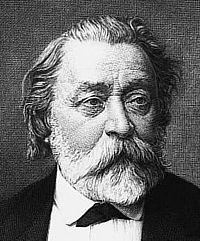Theophil Hansen

Baron Theophil Edvard von Hansen (original Danish name: Theophilus Hansen) (July 13, 1813 in Copenhagen - February 17, 1891 in Vienna) was a Danish architect who later became an Austrian citizen. He became particularly well-known for his buildings and structures in Vienna, and is considered an outstanding representative of neoclassicism.
After training with Karl Friedrich Schinkel and some years studying in Vienna, he moved to Athens in 1837. It was here that he studied architecture and design, with a concentration and interest in Byzantine architecture. During his stay in Athens, Hansen designed the National Observatory of Athens building and two of the three contiguous buildings forming the so-called "classical trilogy", namely the Academy of Athens and the National Library of Greece, the third building of the trilogy being the National and Capodistrian University of Athens, which was designed by his brother Christian Hansen. Upon his move to Vienna in 1846, he took up an apprenticeship with noted Austrian architect Ludwig Förster.
In his early works, such as the museum at The Arsenal in Vienna, Hansen was still rather aligned to a more romantic style. In later years, he became the most outstanding representative of Renaissance-inspired historicism (Neorenaissance), which also came to be known as Viennese-style. This style extended into the smallest details of the interior design and partially accepted the courses of a synthesis of the arts.
Along with Förster and many others, Hansen was one of the most important and influential architects of the Viennese Ringstraße. His most famous work is the Austrian Parliament building, which was created in the style of an ancient, neo-classic temple, and serves to refer to the Greek beginnings of democracy. Hansen was originally a staunch critic of the Classical style that was taught to him at the Copenhagen Academy. Over the years, however, he came to incorporate Classical elements into his forms. Bauleiter on this project was Hans Auer, who would go on to win the competition for the Swiss Bundeshaus.
Hansen's famed Musikverein in Vienna is one of the most notable concert halls in the world; a concert hall whose design and acoustics are often admired and copied in present-day music houses.
Hansen worked together with Viktor Pilz and Carl Rahl, as well as with Otto Wagner. In 1884 Emperor Franz Joseph honoured Hansen with a barony in the Austrian nobility and he was since styled "Freiherr von Hansen".

Works
- Zappeion, Athens, 1845
- Academy of Sciences, Athens, starting from 1856
- Army-Historical Museum in the Arsenal, Vienna, 1856
- Old Municipal Hospital in Patras, Greece, 1857
- Evangelist church at the Matzleinsdorfer cemetery, Vienna, 1858
- Greek-orthodox church at the Fleischmarkt, Vienna, 1858-1861
- Palace of Archduke Wilhelm, Vienna, 1864-1868
- Musikverein, Vienna, 1867-1870
- Academy of Fine Arts Vienna, 1871-1876
- Philharmonic Concert Hall, Brno, 1871-1873
- Vienna Stock Exchange, 1874-1877
- Austrian Parliament Building, Vienna, 1874-1883
Notes
Regarding personal names: Freiherr is a former title (translated as 'Baron'). In Germany since 1919, it forms part of family names. The feminine forms are Freifrau and Freiin.
Image gallery
-
"Academy of Athens", part of the 'Trilogy' of Hansen in downtown Athens
-
The Athens Observatorium
-
Musikverein building in Vienna
-
Goldener Saal in the Musikvereinsgebäude in Vienna
-
The Zappeion in Athens
-
Reichsrat in Vienna, today Austrian Parliament Building
External links
![]() Media related to Theophil Hansen at Wikimedia Commons
Media related to Theophil Hansen at Wikimedia Commons




